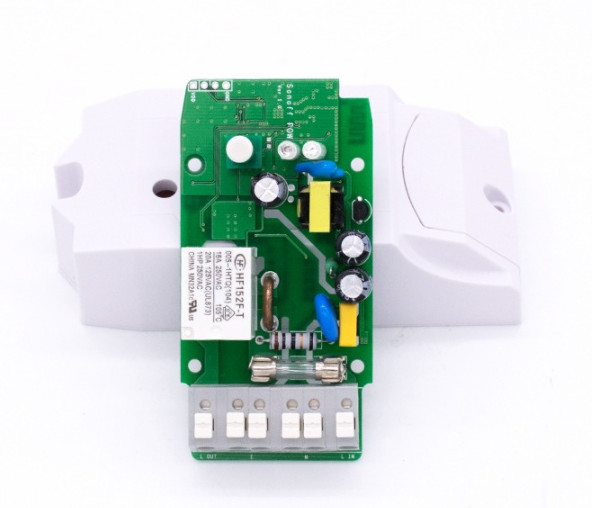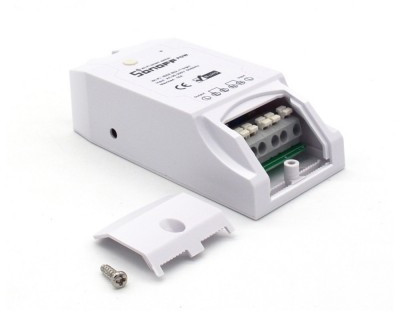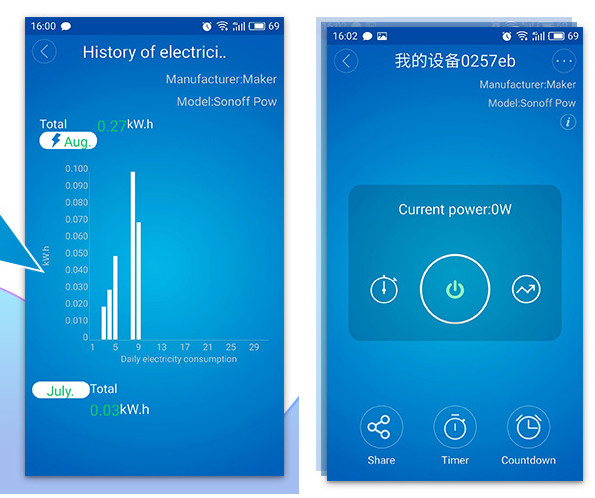In a recent article about Sonoff TH10/TH16 WiFi relays with sensor probes support, we also saw that ITEAD Studio started to have a nice family of home automation products. The company has now added one more item to the Sonoff family with Sonoff Pow support up to 16A/3500W input, and the first to also include power consumption measurements.
- SoC – Espressif ESP8266 Tensila L106 32-bit MCU up to 80/160 MHz with WiFi
- Connectivity – 802.11 b/g/n WiFi with WPA/WPA2 support
- Relay – HF152F-T relay with 90 to 250 VAC input, up to 16A (3500 Watts)
- Terminals – 6 terminal for mains and load’s ground, live and neutral signals.
- Programming – Unpopulated 4-pin header for flashing external firmware
- Misc – LEDs for power and WiFi status, power consumption circuitry with 1% accuracy.
- Dimensions – 114 x 52 x 32mm
- Temperature range – -40 to 125
 The wireless relay can be controlled using Ewelink app for Android or iOS. But beside manually turning on and off the device, or settings timer like with all other Sonoff devices, you can also check real-time, daily or monthly power usage.
The wireless relay can be controlled using Ewelink app for Android or iOS. But beside manually turning on and off the device, or settings timer like with all other Sonoff devices, you can also check real-time, daily or monthly power usage.
There’s some limited info on the Wiki, and I could not find any API incase you want to measure the power consumption from your own app or program. But at least they’ve release the schematics showing HLW8012 chip (Datasheet in Chinese) is used to measure power consumption, and is connected to ESP8266 via SCL and PWM1 pins. The 4-pin header would also allow you to flash you own firmware relatively easily on the board.
The company also mentions “this is a customizable product. Based on the original prototype, we can make the customized prototype that meets your requirements”, so if you order in quantities you should be able to get a slightly modified hardware and customized firmware.
ITEAD Studio home automation products used not to have any kind of CE/FCC/UL/TUV/ETL certifications, but the company recently got CE certification for their Sonoff switch, which explains the CE logo on the unit.
Sonoff Pow is available now for $10.50 plus shipping.
Thanks to Harley for the tip.

Jean-Luc started CNX Software in 2010 as a part-time endeavor, before quitting his job as a software engineering manager, and starting to write daily news, and reviews full time later in 2011.
Support CNX Software! Donate via cryptocurrencies, become a Patron on Patreon, or purchase goods on Amazon or Aliexpress







well, this is one useful thing! and a cheap one!
There become more interesting if you flash on a new firmware like ESP Easy:
http://www.esp8266.nu/index.php/ESPEasy
Some good info the similar Sonoff TH by Xose Pérez (a.k.a. Tinkerman) here:
http://tinkerman.cat/sonoff-th10-th16-sensors-displays-actuators/
Can someone say if this relay box is going to measure the power consumption of the entire house hold or just for power consumption for the ESP8266 board alone? Because I am using some sensors along with esp8266 and that I want to measure how much of voltage is being consumed periodically. Please let me know.
@Harry
Yes the power measurement chip measure the load, not the board only, that would rather be useless.
However, 16A/3550W might not be enough for the entire house. For example, if you use a washing machine and a vacuum cleaner at the same time, it might already be over 4000W. Better get several, maybe one per room depending on the appliances connected.
@Tadej
I wish they had placed the input on one side and the output on the other side. The current design makes it harder than it should be to insert the relay within an existing circuit, as once the cables are cut, they may be too short.
@Harley
Sonoff Pow does not have an interface for sensors like Sonoff TH10/TH16, so ESPEasy might not be suitable for that product.
Yes I noted these did not have a external sensor port. That is a little sad as the exposed sensor port would really have made it easy to test without soldering at all. But internally they still have the same GPIO exposed, just need to solder pins onto them to make testing easier. I have not bought any Sonoff devices before however this Sonoff Pow model makes me want to buy a few just to play around with.
@Harry No I would not use this for an entire household, or even to more than one device.
To meassure power consumption of the entire household you need really proven tech from a more known company.
Itead might say that it is capable of handling 16A but I would not trust that. Recommend that insead connect one of these to each device, not exceding 10A. Rememeber the saying that “you get what you pay for”. These are cheap devices that can be fun to play around with as a hobby or connect to non-vital devices, but I would not chance them to burn down my house just because you connected a 16A radiator.
Suggest that you read all blog posts on Sonoff devices Xose Pérez (a.k.a. Tinkerman):
http://tinkerman.cat/tag/sonoff/
He does teardown of each device and even gives analyzis if they are electricity safe. So sum up he says that Sonoff Pow & TH16 are better than previous models but still not proven. My advice would be to use these as fun only for now, and wait maybe a 12-months or so until they gotten CE/FCC certificates and been tested enough in the real world by others before you start using them for vital infrastructure in your home.
Anybody an idea how much power the board consumes by itself?
Thanks.
I have bougt one, hope my house will not burn down and the EU-Duty let it go in because normaly “no CE no EU…”
But sometimes they don´t know what it is…
@GunterO
Based on the Wiki data, it should consume about 260 mW while transmitting data over WiFi, and even less when not.
A mod says in the comments:
It’s “European Conformity”. We will provide the test report when it is ready.
BTW where does this 260mW figure come from?
In the wiki I could only find
• Standby power consumption is less than 1.0 mW (DTIM3)
Operating current Average: 80mA
@uibo
80 mA * 3.3V =~ 260 mW.
Can You program these things like a timer, so it switches on @ a certain time and switches back of on a certain time?
@Roel
Yes.
@Roel
Similar to the Raspberry Pi and most other single-board computers it does not have a RTC (Real-Time Clock) and battery to keep time when it looses power, but you can use NTP (Network Time Protocol) to get the date and time from example pool.ntp.org via the internet.
@Harley
Thanks but I really prefer RTC and stand alone without internet connection (my router is switched of most of the time). Same problem with my LIFX bulb, it does need that wifi connection and you can’t put it in ap mode (didn’t really investigated though…) I even wonder if you program the bulb if it is really the bulb, or only the phone that instructs the bulb what to do.
The power measurement function is cool thoug.Should it be possibel to pull the dat from the device and put it in a spreadsheet?
You can of course just setup your own NTP server at home. That is what most companies does on their own internal networks.
According Itead’s engineer, the CE sign is real , not “China Export”
Too bad that there is no ready to go extension-cord like device variant. Just plug into wall, plug device in and ready.
API obviously is also very important. These phone apps simply suck for long term.
@Andreas Spiess
Sonoff TH10, TH16, POW and DUAL are CE certified since last Oct 11th (see CE documentation). So this is pretty new.
Can this be configured to be always on? I basically want to only use the power consumption monitoring, and would like it to turn on after a power outage.
Think running my network gear and the pi that controls/monitors it behind this device.
@Sajal
Never mind found this in the post about firmware ” there an option to select whether to turn on or off the relay at boot time, which is great since I need it on at all times”…
@Sajal
Just in case others read this, AFAIK the default firmware does not allow for the relay to be always on, but you can press the button on the unit to turn it on, or use eWelink app.
You’d need to flash ESPurna or another firmware to have the option to automatically turn it on as mentioned in comment #22.
Today the app had an update, so the startup state was introduced. The firware was not changed, still 2.0.4 of about two weeks ago, only the app is changed …. and TADAAAA! Now we can force the relay ON on startup, just tried.